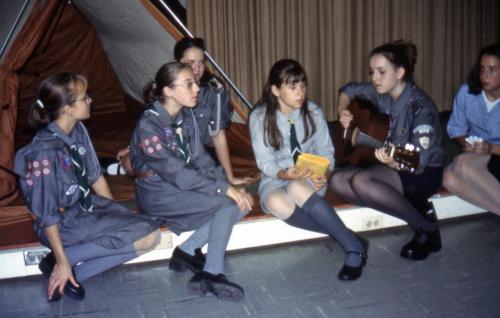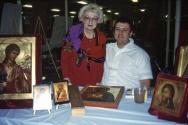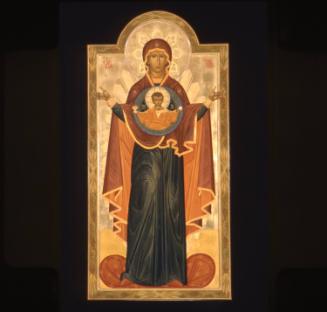Marek Czarnecki and Polish Girl Scouts at Szopka Festival, 2000
SubjectPortrait of
Marek Czarnecki
(Polish-American)
Date2000 November
MediumPositive color film slides
ClassificationsGraphics
Credit LineConnecticut Cultural Heritage Arts Program collections
CopyrightIn Copyright
Object number2015.196.1048.1-.2
DescriptionTwo slide photographs of the Szopka Festival at the Polish National Home in Hartford in November 2000.
(.1) Polish Girl Scouts in uniform. One of the girls is playing a guitar.
(.2) Marek Czarnecki with his mother Jadwiga, posed by Marek's display of icons he has written.
NotesSubject Note: In a continuation of the living tradition of creating nativity scenes from humble and re-used materials, the Polish Cultural Club of Greater Hartford has sponsored the szopka festival, an annual November contest and festival held for many years (until 2020) at the Polish National Home in Hartford. Children from several Greater Hartford schools create their versions of the Szopka Krakowska, designing elaborate mangers to mimic the domes, towers, balconies, and roofs of local buildings in Krakow. They use recycled materials such as juice bottles, aluminum foil, cardboard boxes, and toy figures. The tradition of making elaborate manger scenes depicting the birth of Jesus at Christmas draws from the centuries-old ancient practice of staging nativity plays in village crèches carrying a szopka as a scene or small stage. The word szopka means shed, and refers to the humble stable where Jesus was born. The Szopka Festival sponsored by the Polish Cultural Club of Greater Hartford has been held at the Polish National Home every Thanksgiving weekend for several decades.(.1) Polish Girl Scouts in uniform. One of the girls is playing a guitar.
(.2) Marek Czarnecki with his mother Jadwiga, posed by Marek's display of icons he has written.
Subject Note: The Polish Cultural Club of Greater Hartford “was established in 1976 to preserve and promote the history, culture, and customs of Poland with fellow Americans." An active organization that has held many meetings at the Polish National Home on Charter Oak Avenue in Hartford, the Club sponsors lectures, seasonal celebrations such as Wigilia at Christmas time, the annual szopka festival, and gives scholarships and support to Scouts groups. The Club collaborates with the Polish Foundation and the CCSU Polish Studies Department and Library in New Britain.
Biographical Note: Marek Czarnecki began writing icons in 1990 for his home parish of St. Stanislaus Kostka in Bristol, Connecticut. It was appropriate for this first generation Polish-American that his first icon would be of Our Lady of Czestochowa, the Black Madonna of Poland. Leaving behind a contemporary art education, the icon became his sole interest as an artist. Iconography is a fundamental liturgical art form that provides authentic, meaningful and dignified images which exemplify the larger consciousness of the Christian Church. Icons carry a patrimony of both theology and art, conveying essential dogmatic and biographical information and embodying the presence of the holy ones depicted.
After studying with several iconography teachers, Marek began a life-long apprenticeship with master iconographer Ksenia Pokrovskaya in 1999. He has translated her teachings into an English language technical manual for iconographers, and taught workshops with her at several national sites, including St. Tikhon's Seminary in South Canaan, Pennsylvania. Following established tradition, Marek’s icons are made with natural materials; the foundation is linen glued to a wood panel and primed with a marble-based gesso. Painted with egg tempera mixed with natural earth and mineral pigments, the halos and backgrounds are gilded with 22 karat gold. The icon is then varnished with copal resin.
Marek’s icons can be found in in the homes and chapels of individuals, as well as churches across the country, including the Catholic Cathedral of the Immaculate Conception in Springfield, Illinois, the Franciscan University of Steubenville, St. Thomas More Chapel at Yale University, and Sean Cardinal O'Malley. His icon of "Christ the Eternal High Priest", originally written for a seminary chapel, gained him international attention when it was chosen by the United States Council of Catholic Bishops as the image to represent "The Year of the Priest". This icon was widely distributed; more than a million copies were printed, reproduced, and used in dioceses as distant as London, Stockholm, Singapore, and Sydney. Marek is also a skilled restoration artist, working with statues from churches across the country, and he creates ornaments and installations to mark festivals and holy seasons in his parish church of St. Stanislaus in Bristol Connecticut.
Marek helped edit the book, "Hidden and Triumphant: The Struggle to Save Russian Iconography in Twentieth Century Russia" (Paraclete Press, 2010). He continues to teach and write icons out of his studio in Meriden, Connecticut. He has won a Connecticut Commission on the Arts Painting Fellowship in 1996 and 2004, the 1998 American Council for Polish Culture Award, the 2006 Polish American Historical Association Outstanding Achievement Award, and a Southern New England Traditional Arts Apprenticeship Grant to teach an advanced student. Articles on his work have appeared in the Hartford Courant, St. Anthony Messenger, Catholic Digest, Our Sunday Visitor, and New York Times.
Additional audio, video, and/or photographic materials exist in the archive relating to this community and these events.
Cataloging Note: This project was made possible in part by the Institute of Museum and Library Services MA-245929-OMS-20.
Status
Not on view2000-2001 December-March














